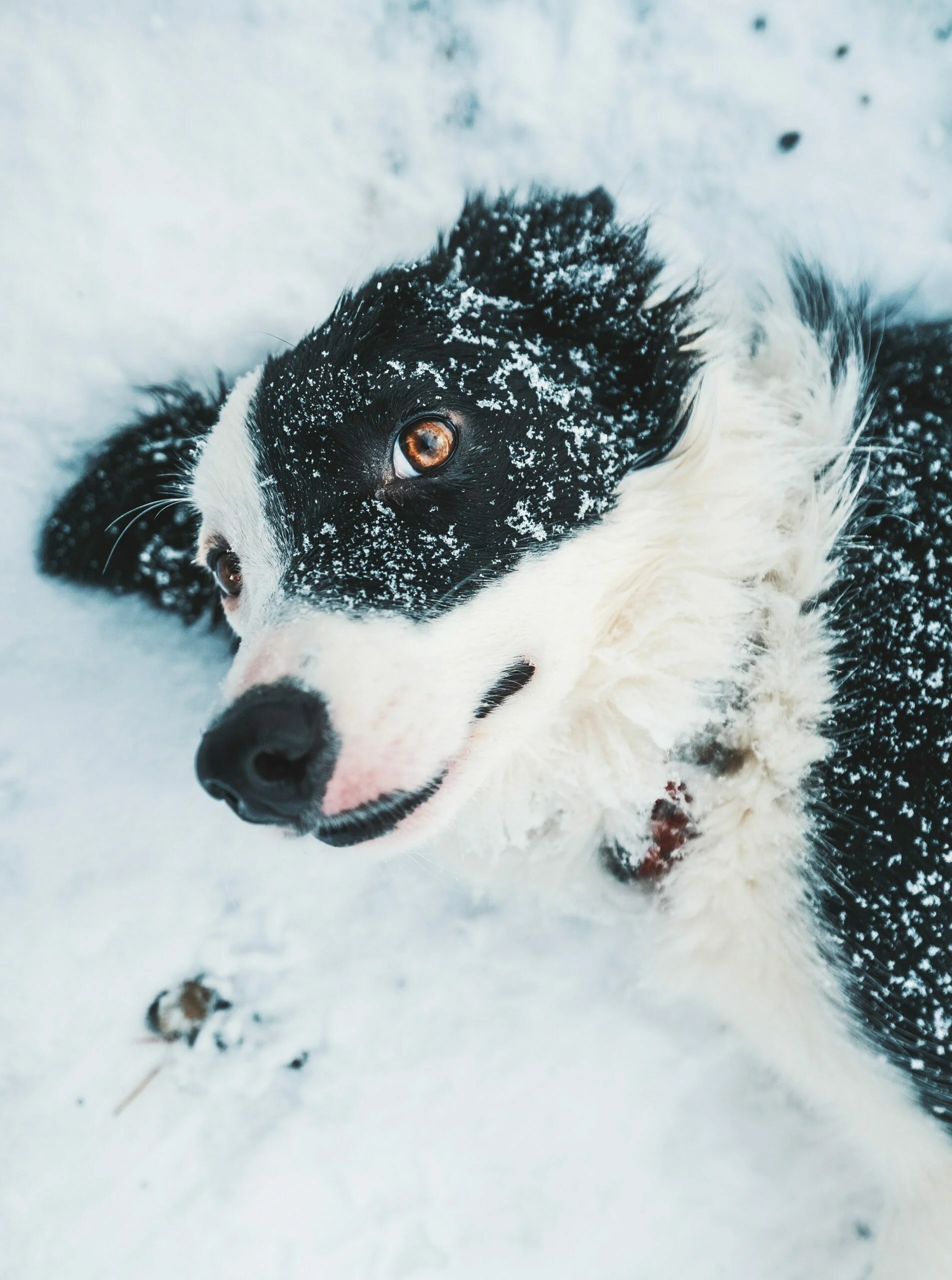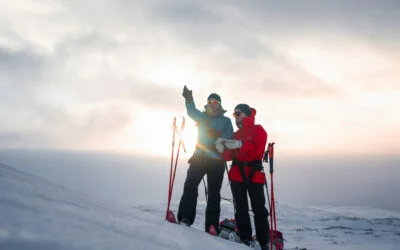Rules for dogs in the mountains?
Every Norwegian with a pair of hiking boots knows the time-honoured “Fjellvettreglene”, the famous mountain code – nine rules to follow for a safe trip to the mountains on foot or skis. But human hikers aren’t the only ones who face challenges in the mountains. It’s just as important that we look after the dogs! That’s why we’ve created some special dog-oriented rules for the dog. Feel free to share them with all your friends, human or canine!1. Adapt your trip to your ability and conditions
Short walks for older and smaller dogs, (gradually) longer walks for young dogs. Take a rest day if there’s a lot of activity or if the weather’s bad. Mental stimulation through training drills, hunting for treats, husbandry training, obedience training, feeding with a frozen kong, a snuffle-mat or searching can wear out the dog just as much as physical exercise. Be creative and make sure your dog gets to use their head and senses, even if you’re not out on a long trip.Care for the outdoors-dog
If you take some precautions and get your preparation right then the trip with your dog’ll be easier. On cold tours, there are one or two crucial things to bear in mind to keep your dog from injury. We break it all down.
2. Plan the trip – and let others know where you’re going
VAlways know where you are. Always know where the dog is in relation to you. Use a map and compass. Consider a GPS tag for your dog. Planning is never wrong.3. Choose a safe route
Recognise avalanche-prone terrain and unsafe ice. Bring an extra power bank for your phone. A GPS tracking tag attached to the dog’s collar offers increased security. Ask a friend to follow the dog’s GPS on a tracking app, so you’re doubly safe.4. Pay heed to weather and wind
Use a dog jacket or a bivvybag when it’s very cold or when you’re not active. Protect exposed body parts and skin. Use sunscreen on unpigmented, thin-furred dogs. Protect eyes from sun, weather and wind. Dogs can get sunburned, and thin-furred breeds are more prone to sunburn than others. The ears and nose are particularly exposed, as well as parts of the body without hair and pigment. Sunburn appears as sharp red marks or, at worst, blisters. Cover the dog or use sunscreen if the sun’s very strong.Show respect for the sun
Dogs can become snowblind, too, if they’e exposed to strong sun and UV radiation. On the whole, dogs aren’t as susceptible as we are – but certain dog breeds (and dogs with reduced tear production) are more susceptible to snowblindness. Solar radiation is strong in the mountains, so pay attention to the dog’s behaviour. Snow blindness often manifests with the eyes starting to run. They become red and irritated. If the dog closes its eyes and seeks shade, avoiding light, this might be an indication of trouble.5. Be prepared for sudden storms and cold
Even on short trips out, the weather can change quickly. Always have a bivvybag, jacket, paw socks, high-energy snacks and water with you.
Watch out for saw pores
Check the paws regularly: if they need care and treatment, it’s the sooner the better. Long fur between the pads can lead to ice and snow clumping up the feet and even the legs. Paw ointment can prevent this. It may also be a good idea to trim the tufts of fur that stick out from under the paws of hairy breeds (don’t trim between the pads, though). If you have skis with steel edges, keep an eye out (training can help here, too). Make sure your dog has well-groomed claws. Long claws crack, break and chip more easily. Claw injuries can be very painful. Use socks if the dog has injuries or wounds. Socks can prevent injuries, but make sure they’re fitted correctly. No one likes blisters or sores!Take care of puppies in the cold
Not all dog breeds are equally well adapted to the cold. Time spent outside must be appropriate for the temperature. Puppies don’t have the same ability to regulate their body temperature that grown dogs do, so it’s important to pay special attention to young dogs. Learn to read your dog! A shivering dog may be freezing – but it might mean that it’s excited/happy.6. Bring the equipment required to help yourself and others
A first aid kid (especially paw socks and elastic bandages) is crucial if a claw breaks or the dog gets a cut.Always remember to bring a first aid kit for the dog
What should be included in a dog’s first aid kit? Read more about that here.
7. Turn back at the right time: there’s no shame in turning around
Never underestimate how hard it is for an untrained dog to walk and run in snow. Dogs get tired, too – and they don’t glide like skis do! Suit the speed and length of the trip to the dog’s training. Show consideration for others on the trail, too. Walking in loose snow, pulling a pulk or a person, is quite a task. So train well before expeditions. If you have a larger dog, it’s not so easy to carry it home if its strength fails.8. Conserve your energy – seek shelter if necessary
Taking a break isn’t against the law! The dog can rest a while in the bivvy bag with a snack and a refill. Have one yourself.Remember
Cold can sap your strength – even more when you’re tired. And the same is true for dogs. If you need a shelter, don’t wait until it’s too late. Dogs use more energy when they’re active, and when it’s cold, maintaining body temperature. Remember this at feeding time. On a demanding excursion, extra feed (or add extra fat in the feed!) is recommended. Remember bottles of water and a drinking bowl, too – dogs get thirsty, too.9. Keep snacks out of your dog’s reach
Dogs can’t tolerate the substance theobromine, found in coffee, tea, cola, cocoa and chocolate products. Even small amounts of chocolate can cause an irregular pulse and breathing. In the worst case, the dog can be poisoned. Stay away from chocolate snacks. And keep human snacks away from the dog altogether. Spend a moment to find out where the nearest vet is in case the situation demands it – and make a note of the number and the address.10. Keep yourself up to speed
Stay on top of what you need to know. Download apps such as FirstVet. ast ned apper som f.eks FirstVet, Update yourself on dog first-aid. Before you head out, make sure you’ve stocked your first-aid kit and dog pharmacy. Consult a vet before an expedition. Does your dog need other medications? What are its special needs? Travelling abroad, see if you need vaccinations, a dog passport or other papers.The Norwegian Kennel Club’s “Dog in the Easter Hills” training and quiz
Do you know how to have the best Easter holiday with your dog? In this breakdown, you’ll find a smorgasbord of tips, hacks, and things to think about!

The Dog’s Mountain Code

Written by
Crister Næss
Crister lives and breathes for skiing and the outdoor life. During his time working for Åsnes, he was commonly found with a pair of prototype Åsnes skis on his feet with his dog in the mountains of Voss.

So – what exactly is a skin, anyway?
Skins are more than a strip of carpet with glue on the back. They’re tools designed to help us in pursuit of pristine snow, perfect lines, and/or solitude. Something this magical demands a proper description of how it’s made.

Firing up the stove in winter
Nothing whets the appetite more than a long day skiing in the winter mountains. Fire up the burner, boil some water for some tea and reach for the packet of dehydrated chilli: paradise found. But doing this in the winter you need to bear a couple of things in mind. So here are some wily strategies to make things easy and safe.

Seven tips to find a safe route up the mountain
Here are some simple, concrete, tips on how to find the safest route up a mountain on skis. Some things in life are necessary. Some things aren’t necessarily easy. But, as every skier knows, the only thing that really matters is skiing as much as humanly possible – so getting these down is a question of making life worth living.

Digital tools for the ski tour
Don’t give up if your go-to spots are snowless or unskiable wastes. There could well be untouched, soft powder in them there hills! Read on to find digital tools for finding the white stuff when all hope is lost…

The Mountain Code
Being mountain-wise isn’t a question of knowing what you should and shouldn’t do. It’s about having a conscious relationship with nature; the choices you make; the actions you take. The Mountain Code guides everything from planning you trip to adapting your plans according to what greets you out in the wilds. Here’s a look at the rules, with material largely taken from the creators of the new Mountain Code (2016), the Red Cross and DNT.

13 tips for better orienteering.
Few of us set out into the winter mountains when the weather’s bad and visibility’s poor. And we’re careful for good reason. It’s risky. When nature shows its muscles, it forces us to reflect. Even so, Norway’s a country with plenty of mountains and even more weather. If we only headed out when the sun was shining, the season would be very short. We head out when the weather’s less than perfect – which means we need to be able to find our way with a map and compass. Here are 13 tips for using a map and compass, then, for those of us hitting the mountains in winter.